The splendours of central Mexico
Mazatlan felt very familiar and comfortable for us as we drove off our ferry from Baja and started our trek across central Mexico. We were in the Mexican travel groove and parked Tramp so we could explore the old historical centre of this large seaport city. The large ornate cathedral sparkled in the warm sunshine, the nearby market was abuzz with locals buying and selling their wares and the old buildings that lined the narrow streets – some too narrow for Tramp – were great fun to explore. Plus Mazatlan has a great name. We liked the place.
We drove along the winding promenade for some time, stopping for photos and to take in the vibe of the place, before heading towards our first inland city, the ancient mining community of Durango. But Durango is at about 2,000 metres (6,500 feet) above sea level and the most entertaining way to get there is via the new (and dastardly expensive) toll road which winds and climbs and dips its way up and over the rugged mountain range which separates the high plains from the sea.
This was a road trip for the ages. We didn’t count but there would have been literally hundreds of bridges and tunnels, sometimes running in tight alternating sequences without any ‘normal’ land between them, snaking their way up, through and around these steep mountains, providing spectacular views in all directions. And to add to the experience, crazy locals driving like mad, passing over double yellow lines around blind corners while other cars and trucks go barely half the official speed limit.
Included in this jaw-dropping journey is the Puente Baluarte, at 420 metres (1,300 feet), the highest bridge in the Americas and one tunnel that is almost 3 kilometres (2 miles) long. It was a challenging but extraordinary drive, for sure. The mountains with their jagged silhouettes, deep canyons and high escarpment walls provided the setting, the engineering miracle of a road provided the access and the drivers provided the entertainment. Oh ya!
The remote city of Durango was settled in the 16th century as a mining centre and has prospered ever since. We were aiming for one of their nearby hot springs to camp but when we arrived at dusk and it was closed we flexibly chose the grounds of the modest church in the little village nearby to camp. It was safe, quiet (except for the early morning roosters) and perfect after a long and eventful day.
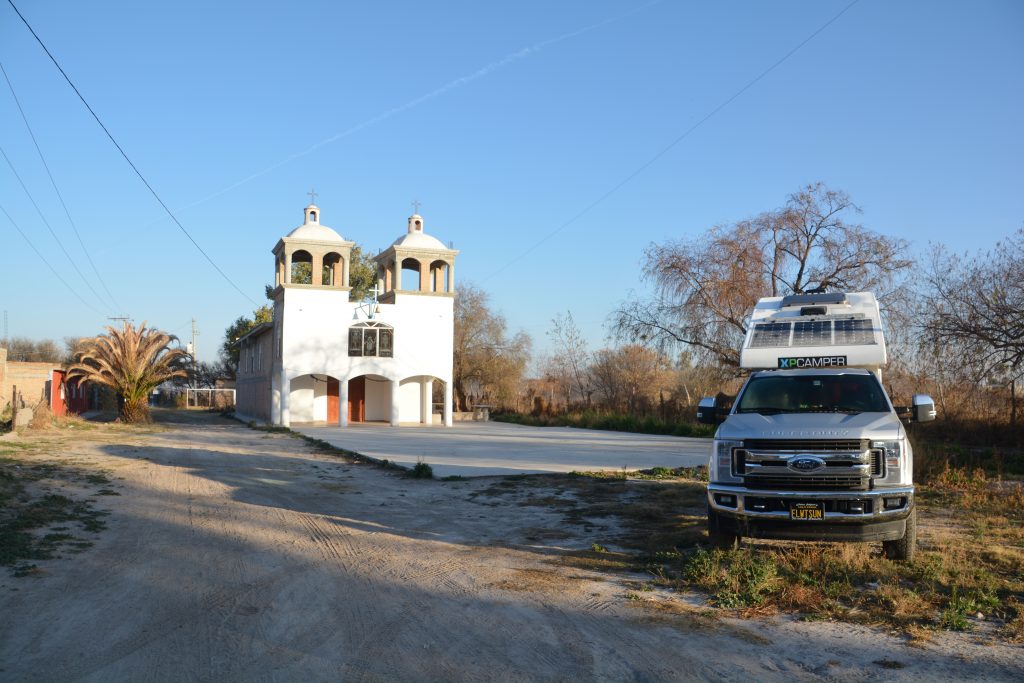
Tramp goes religious, and with good reason – we needed a place to camp and a nearby village lent us their church
Heading further south and inland, our next target was the historic mining town of Zacatecas, another city with a cool name, which sits at about 2,400 metres (taller than Mt. Kosciusko; about 7,400 feet) and was the base of an enormous silver mining industry that the Spanish developed from the 17th century. But we also had two chores to deal with – first, to somehow get drinkable water into our water tank, and second, to fix the slow leak that Tramp had developed in his right rear paw.
The challenge with the drinking water is twofold: you must be able to find water that is potable and you must be able to get it into the tank, of which the cap and opening is high above my head. Don’t ask, that’s how it was designed. In the US or Canada we were able to simply hook up our short garden hose to any tap and turn it on – presto!
But in Mexico, and all further points, tap water is not drinkable. We bought a 20 litre bottle and managed to pour it into the opening – very difficult, inefficient and ineffective. We then visited an auto parts store and the nice guy there – Jorge – went to his car and gave me a thin hose he uses to siphon water or gas, as required. A little cleaning and it was ready to use.

Muscle man – I pour the final touches of a 20 litre water bottle into our elevated tank, all possible due to a borrowed ladder
Tramp has huge ten ply light truck tires which we thought would last for a long time. But one of them took a couple of long cactus thorns to the sidewall when we were desert camping and forced us to fill it up a couple of times a day. Luckily a great llantera, or tire shop, in a small town whipped the tire off, found the holes, plugged them and set us back on our way for the princely sum of 100 Pesos, about $5.20.
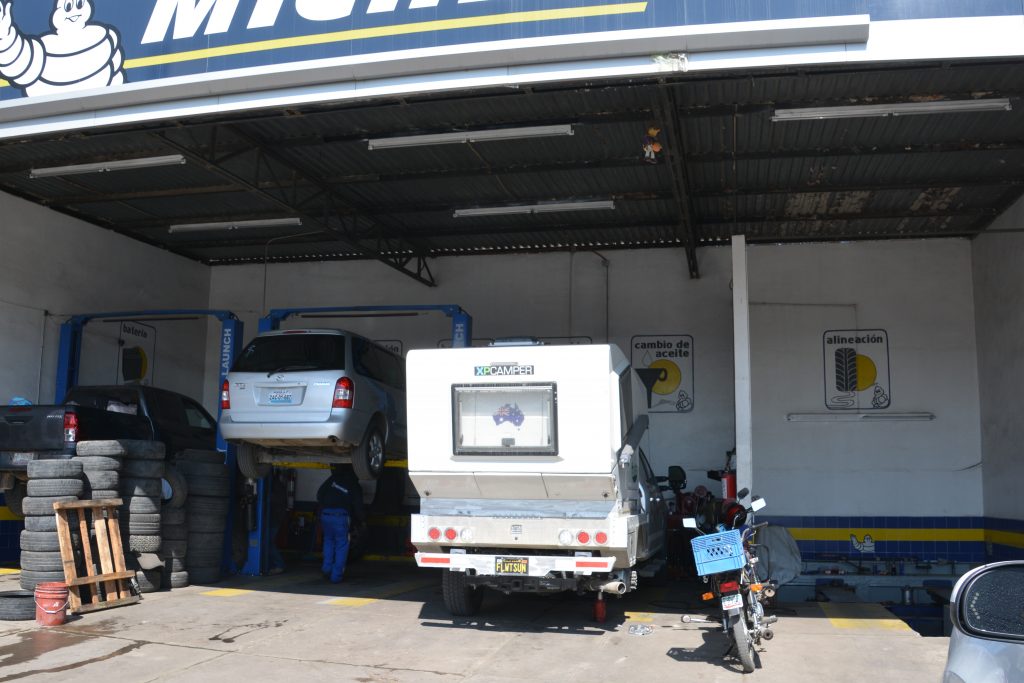
We pulled into this tire repair shop and got presidential treatment plugging two small leaks in a rear tire
Zacatecas is bursting with Mexican colonial charm – narrow cobblestone streets, 150 year old buildings featuring wrought iron balconies, a fabulously detailed Mexican Baroque cathedral and great little shops hidden behind small doors. We visited the Raphael Coronel Museum, housed in an 18th century church and monastery, which featured a collection of 3,000 masks from various regions and used for ceremonial, religious or celebratory events. There were masks of all sizes, all features, colours, materials and expressions, some a bit bizarre, some a bit scary. We had great fun seeing them all.
We pushed on to the little town of Jerez, which our guide book called ‘as Mexican as tortillas’ and then camped at the locked gate of La Quemada, the northern most Mesoamerican ruins. The next morning we were the first car in when they opened the gate and had the place all to ourselves as we spent two hours wandering amongst these fascinating ruins, many of them partially reconstructed.
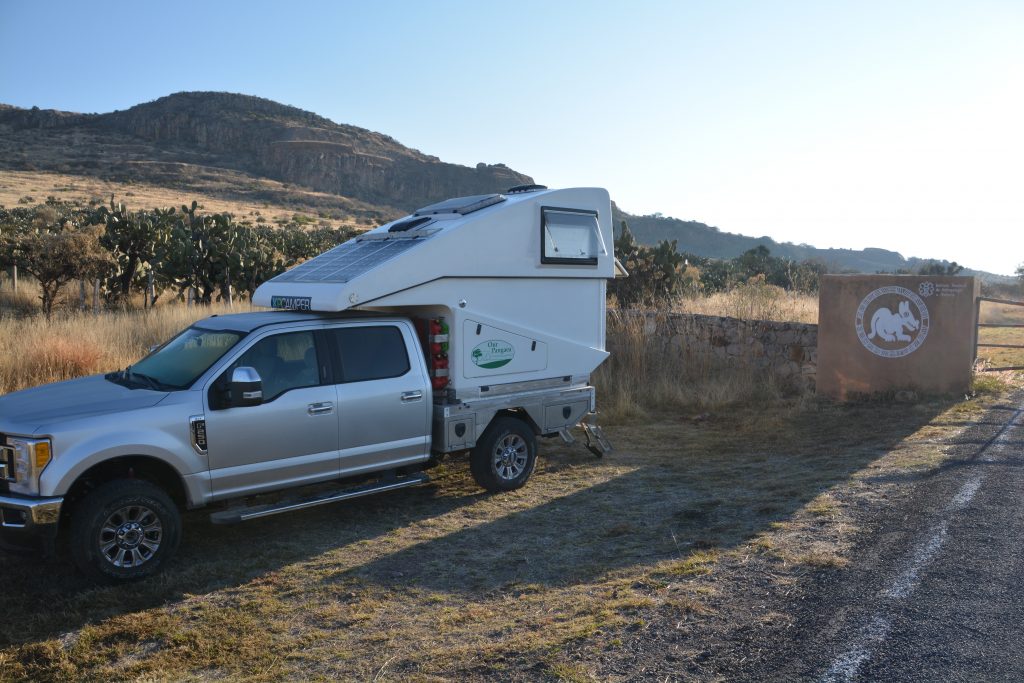
Keen campers – we camped outside the gates of the La Quemada ruins and had the place to ourselves for two hours the next morning
Up to 3,000 people lived in La Quemada between 500 and 900 AD. Experts are not sure of their connection or relationship with other Mesoamerican civilisations but they may have been the northern outpost for the Aztecs who flourished further south near modern day Mexico City. Whatever their origins they had a very substantial and elaborate city on the top of a hill in an impenetrable position. And there’s evidence of human sacrifice which always makes life more interesting.
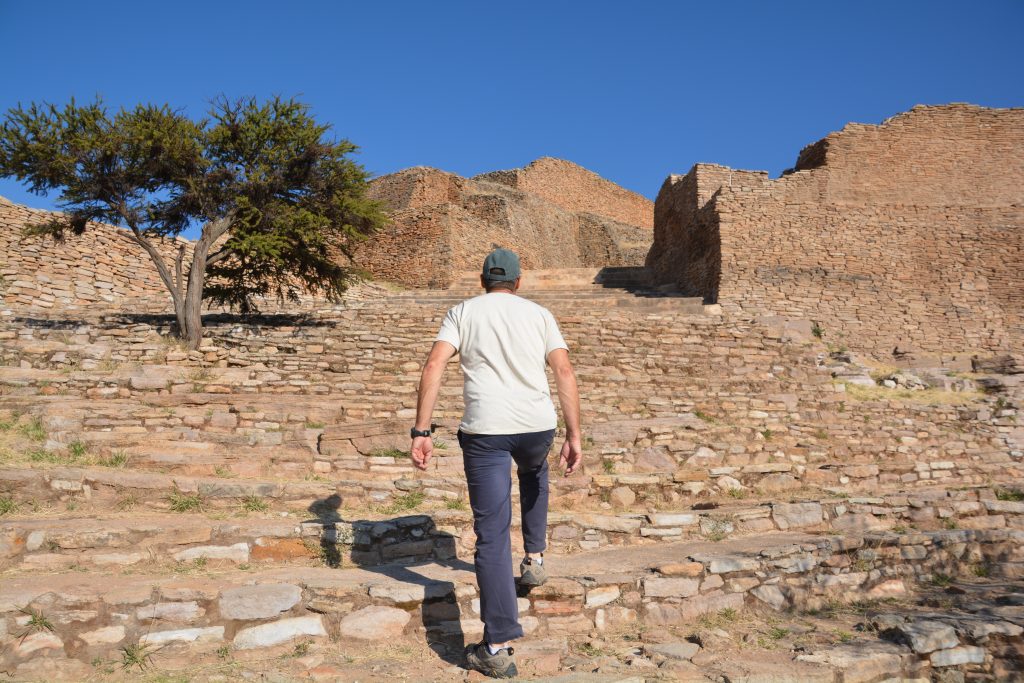
This place was strategically placed on top of a steep hill which made it easy to defend but harder to explore
We pushed further south through more brown rolling hills, mostly desert with cacti and scrub but occasionally there was evidence of ranchers trying to make a peso or two running cattle. The dusty villages we passed through lacked any prosperity but we loved the men all wearing their handsome straw cowboy hats, straight out of a movie.
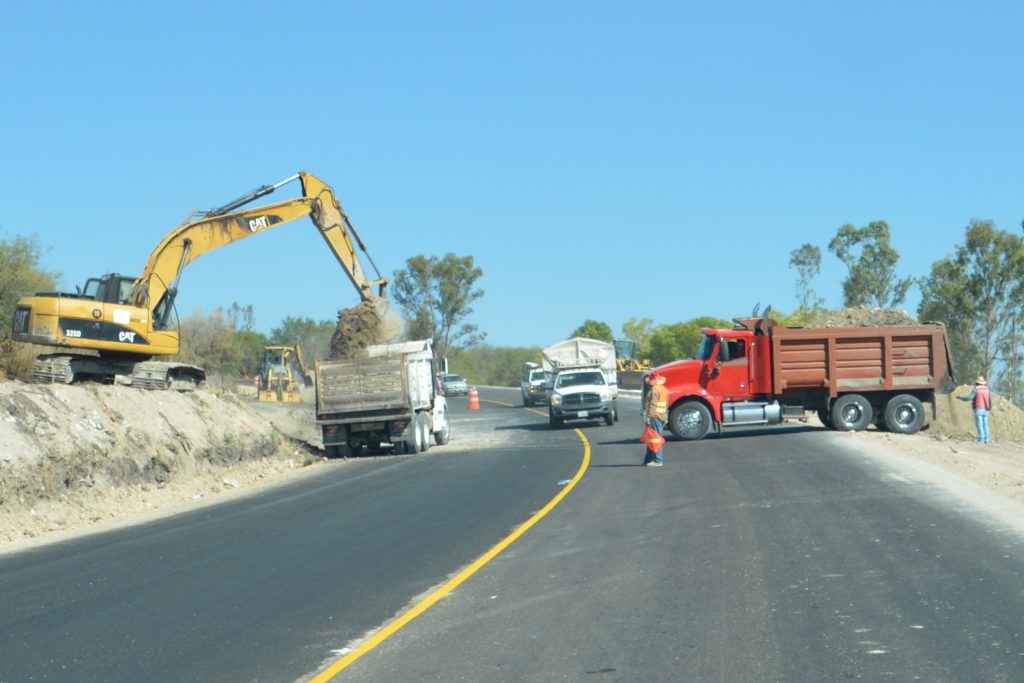
Road repairs Mexican style – a backhoe messily fills a truck while passing vehicles are waved through
A few turns and a few more expensive toll roads later we made our way to the UNESCO World Heritage city of Guanajuato. Guanajuato is now a bopping university town but it’s origins date back to the silver mining days of the late 16th century which enriched many newly settled Spaniards. Today the historical centre of the city is perched on steep hills with narrow cobblestone winding roads either snaking their way through the brightly painted homes or ploughing straight through the mountains in a unique network of long tunnels that connect various parts of the city.
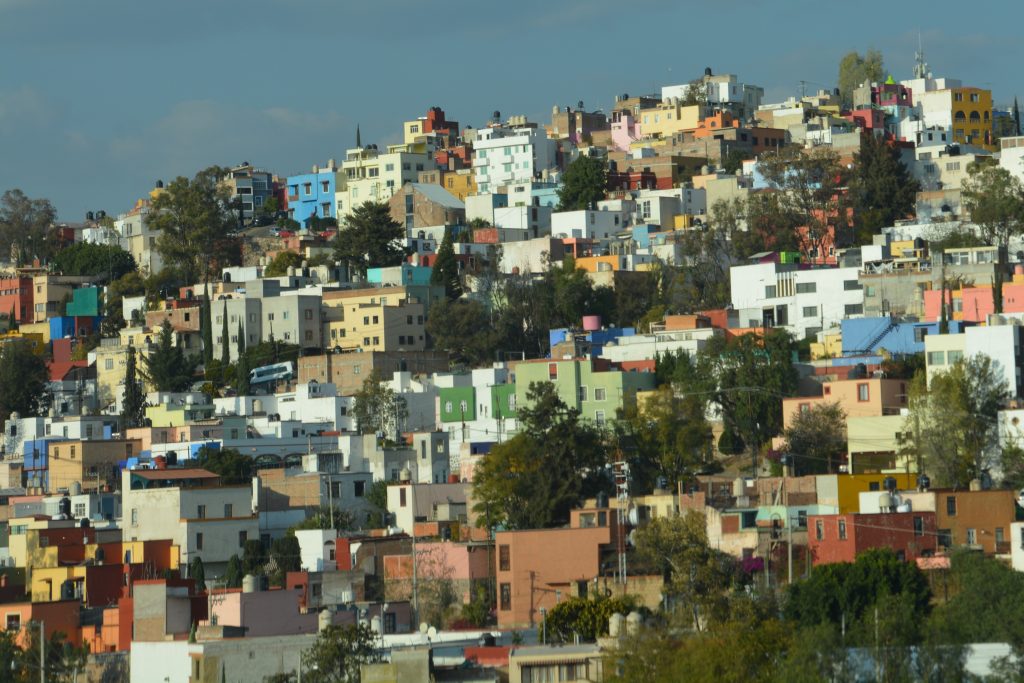
Entering Guanajuato was like entering another world full of colour, history and a unique living environment
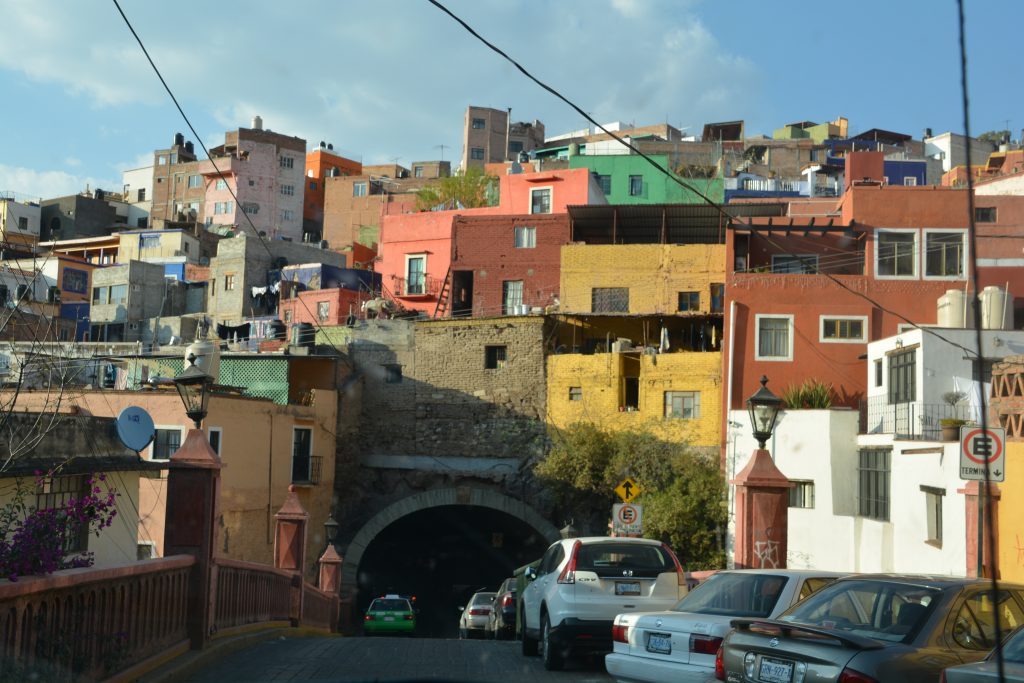
Long tunnels, sometimes with intersections deep underground, were the only way to get around in this exceptionally hilly town
We camped in small campground, more the backyard of a local, at the top of a hill after following a narrow steep road that scared the hell out of Tramp. From there we retraced our path on foot down the smooth cobblestones, walked through the tunnel and popped out in the centre of this old town. Here the streets were narrow, the buildings were old and the little plazas featured small fountains, sidewalk restaurants and mariachi bands.
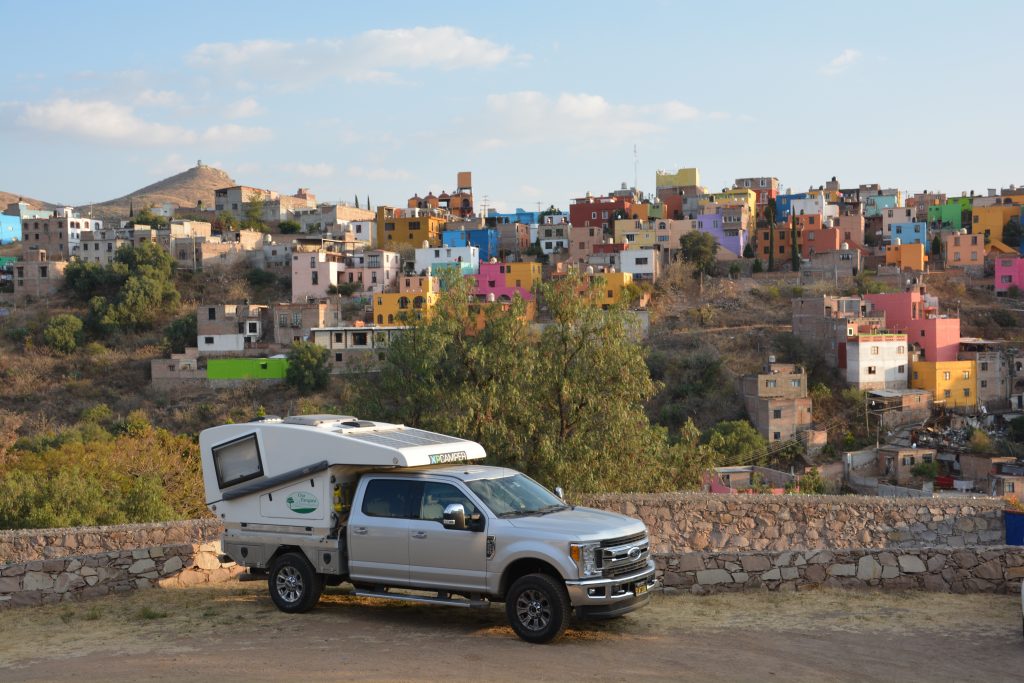
One of Tramp’s favourite campsites, perched on the top of a hill with grand views of the colourful neighbourhood
The downtown streets were packed with young people and families out celebrating the last evening of their extended Christmas season with music, street stalls, costumes, balloons and a parade. Julie and I dove into the crowd and took in the buzzing atmosphere, checked out the illuminated baroque basilica and had drinks and dinner in an old restaurant before trudging back up the hill, ending a great day.
The next morning we chatted to a couple of young travellers who were spending a month in Guanajuato taking Spanish lessons – what a great city for that project! Reluctantly we moved on, weaving our way down the narrow streets and heading south, mainly on these damn expensive but unavoidable tollways, past Irapuato and Queretaro, through more brown dry ranch land and semi-desert.
The tollways are goodish but exhausting. The huge long trucks dominate the road, some driving fast but mostly different degrees of slow. All other vehicles, including some locals who drive at rocket speed, must fit in and around the trucks. There is some kamikaze driving, especially once you get up over 100kph (60mph) and the surface is notoriously inconsistent with smooth sections followed by rough uneven cracked pavement. We’ve already paid close to $100 for the privilege of these toll roads and I’m sure there’s more to come.
We were heading towards Teotihuacan, the famous Aztec capital and perhaps the grandest set of pyramids and ruins from the entire Mesoamerican era. Teotihuacan, or Teo to his mates, sits just north of Mexico City, a huge metropolitan area with more than 20 million people. We were passing through yet another toll plaza when we were stopped by some local police who told us through their translator app that foreign vehicles can’t travel on Saturday in Mexico City and we had to pay an ‘infraction’ of 4,800 Pesos, about US$250.
Did we smell a rat? Well, we knew this was ridiculous and a total police rip-off scam so we politely disagreed and debated this issue back and forth for 20 minutes. Eventually the ‘boss’ came over to restate the same thing but when we politely refused, saying the infraction was way way way too high, they started to agree to a lower amount. In the end they accepted 500 Pesos, about $26, but the whole thing was tense and extremely frustrating.
This guy was the quintessential bad Mexican cop, fat with a huge puffy face, tight uniform, knock-off reflective glasses, persistent but pretending to be pleasant. We had to also be persistent and polite through the whole process but in the end we knew we had to pay something in order to get out of our predicament. Damn it, I boiled for an hour afterwards…but we’re in Mexico.
We arrived at a lovely grassy campground near the Teo ruins and relaxed for the rest of the afternoon before facing the weekend crowds at this famous historical site.
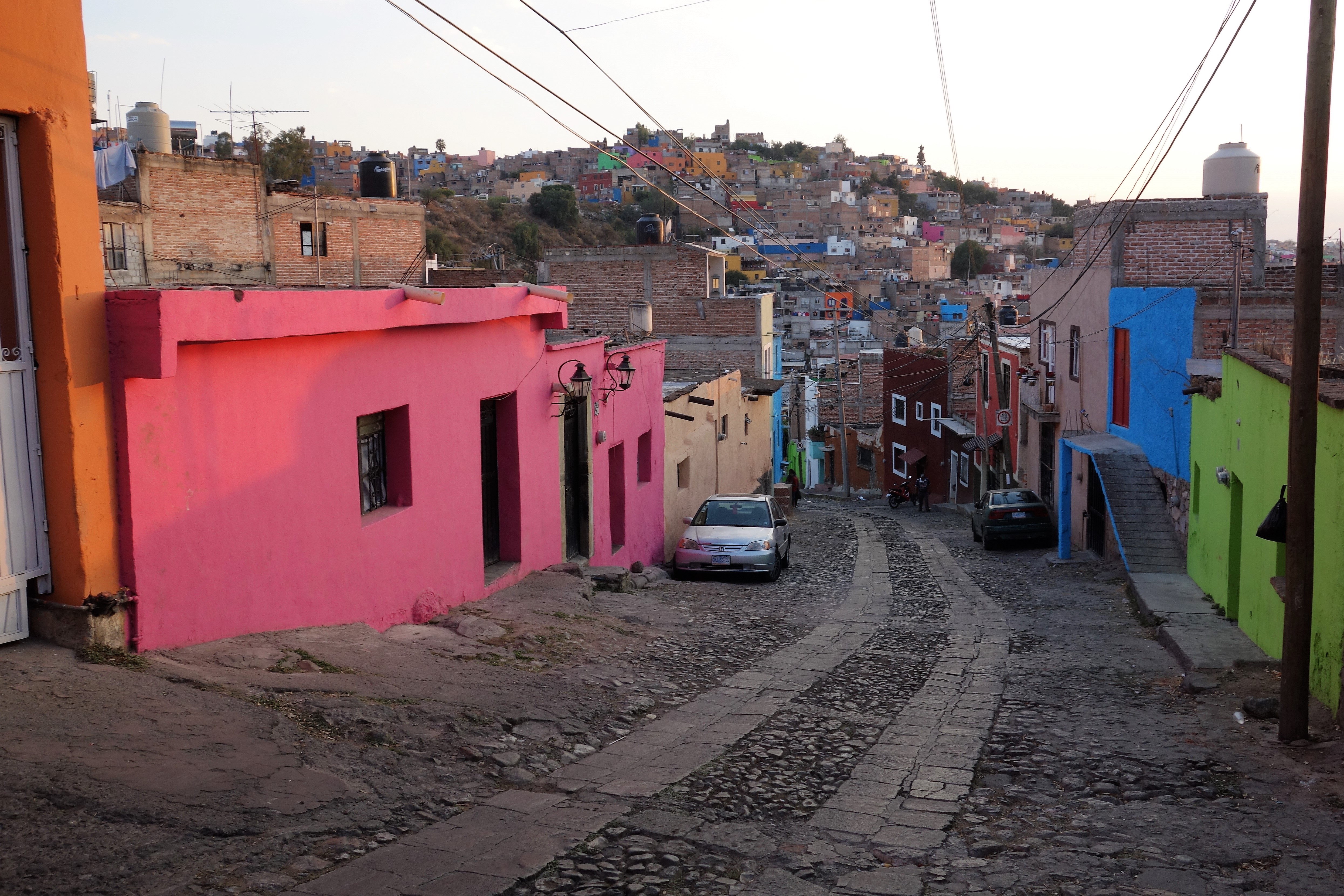





















Comments
The splendours of central Mexico — No Comments
HTML tags allowed in your comment: <a href="" title=""> <abbr title=""> <acronym title=""> <b> <blockquote cite=""> <cite> <code> <del datetime=""> <em> <i> <q cite=""> <s> <strike> <strong>